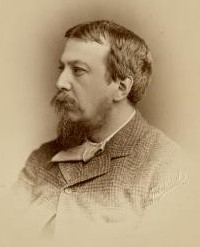Red City (The)
Essay
Written by Silas Weir Mitchell (1829-1914) and published in 1908, The Red City: A Historical Novel of the Second Administration of President Washington is a historical romance, a genre whose plot typically consists of a quest, followed by trials, and ending in marriage. Mitchell presents a view of Philadelphia in the 1790s as politically divided between the Federalists and the Republicans and serving as a refuge for French émigrés, all the while managing to glorify his native city, which served as the nation’s capital. Philadelphia is the red city of the novel’s title, so-named for its red brick buildings.

Set during the French Revolution, The Red City tells the story of Vicomte Rene De Courval, a French émigré. After a Jacobin mob murders his father, and Carteaux, the villain of the novel, exposes him as an aristocrat, De Courval travels to America with his ailing mother. While boarding in the home of the Quaker widow Mary Swanwick and aided by Hugh Wynne—the protagonist of Mitchell’s novel Hugh Wynne: Free Quaker (1897)—Rene learns about this new country, works hard, and endures hardships that help to usher him into manhood.
Rene also experiences Philadelphia’s yellow fever epidemic of 1793, which devastated the city and killed an estimated 5,000 people, and sees the effects of the slave revolt in Santo Domingo when white French residents and their slaves arrive in Philadelphia, fleeing the rebellion. Ultimately, he foils the treacherous Carteaux. As dictated by the novel’s genre, the plot sees the hero, Rene, marry the commoner Quaker Margaret Swanwick, and return to his aristocratic position in France, becoming a general in Napoleon’s army.
The author Mitchell was a respected Philadelphia physician in addition to being a popular writer. Hugh Wynne: Free Quaker proved to be the most popular of his novels, but The Red City sold over 50,000 copies and was serialized for $12,000, the highest price paid for any of his works. The importance of this particular work is its presentation of a post-Revolutionary America and the struggle to unite the new country despite the differences in people’s moral and political values. It also demonstrates how America, despite winning its own independence, was disrupted by revolutions occurring abroad as émigrés arrived on American soil.
Joanna Kolendo is an Assistant Professor of Library and Information Services at Chicago State University, where she works as a Reference & Electronic Resources Librarian. She received an M.S. from the University of Illinois in Urbana-Champaign and an M.Phil. from Trinity College Dublin, Ireland. (Author information current at time of publication.)
Copyright 2016, Rutgers University
Gallery
Backgrounders
Connecting Headlines with History